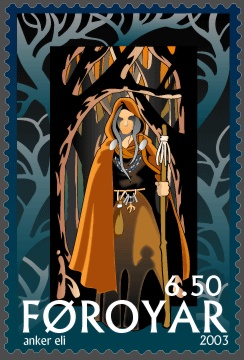What Is A Völva?
A Völva is a female Shaman in Old Norse culture, religion, and mythology.
(There are two spellings of the word. Vǫlva is the Old Norse spelling, and Völva is the Icelandic spelling. The ö character is more easily accessible on modern keyboards, which is why you see it used more often and interchangeably with ǫ, particularly in social media.)
The word Vǫlva comes from the Old Norse word “vǫlr” which means “wand.” Vǫlva literally translates to “of a wand” and culturally translates to “wand carrier.”
In Old Norse society, the word “wand” was a reference to a Distaff — a wooden staff designed to hold a bundle of raw fiber (e.g. flax or wool) while a woman spun it into thread or yarn. Though women and men in Old Norse society did participate in many gender-neutral tasks and responsibilities, the art of spinning thread and weaving it into cloth was exclusively considered women’s work, which is why Völva — the practitioners of Norse shamanism — were almost exclusively women.
A Völva practiced three different kinds of indigenous magic within Old Norse society:
Seiðr, or shamanic ritual, was the ceremonial weaving of a new or different future utilizing the distaff as a ritual wand. Ceremonies included drumming, music, dance, herbal concoctions, and often more than one person would be involved. A Völva’s role was to oversee preparations and guide the ceremony to both its climax (energetic result) and conclusion (communal resolution). Seiðr often included both Spá and Galdr.
Spá, or prophecy, was the art of foreseeing the fates that were being continuously woven into existence by the Norns. A Völva was versed in the art of divination; not only in casting ritual objects and/or reading omens, but delivering their portents in language that others could both understand and utilize.
Galdr, or incantation, was the art of singing or chanting for the purposes of changing or influencing an outcome. A Völva would combine various forms of vocalization, including chanting, singing, and screaming or yelling, with carefully chosen words that often rhymed or formed what we think of today as specifically metered stanzas.
In essence, a Völva was a woman who represented the gods’ influence over Wyrd, or Fate, within Old Norse society. The goddess Freya was considered to be the original Völva; it was she who brought the practice of Seiðr to Midgard (Earth) and Völva looked to her for guidance and protection.
As a Völva grew into her role in Old Norse society, which modernity now labels the Wise Woman, she often left her family and other domestic responsibilities to travel from village to village, exchanging her gifts and skills for various forms of payment that included shelter, protection, food and drink, and treasure or riches. Völva were respected and revered in pre-Christian Norse society; burial sites include jewelry, herbs, horses, wagons, and other physical symbols of cultural wealth and sophistication.
It wasn’t until the introduction of Christianity into Northern Europe that the Vǫlur (plural for Vǫlva) were labeled witches, demons, or practitioners of black arts; the Vǫlur were prosecuted for centuries by both Catholic and Christian religious organizations.
Because there are so few sources of original Old Norse writing and literature that survive today, the historically accurate depiction of a Völva doesn’t truly exist. What knowledge we do have has survived through the writings of Christian authors describing Old Norse society (not always kindly or accurately), archeological sites, and/or scholars piecing together fragments of tomes or scrolls that are damaged or weathered. Old Norse society did not rely on the written word to capture history; it was primarily an oral tradition society, and so Sagas, or stories, that feature the Vǫlur must be taken in context.
The concept of the Völva has seen a resurgence in modern society as religious groups that practice Paganism, Heathenry, and/or Asatru have been officially recognized and granted freedom of religious expression in countries around the world.
That being said, it’s important to note that a person who identifies as Völva — which is to say, a practitioner of spirituality or magic rooted in the Norse tradition — does not need to identify as a Pagan, Heathen, or member of any specific religion to be recognized within her role as it exists in modern society.
A depiction of a vǫlva on a Faroese stamp by Anker Eli Petersen (2003).
